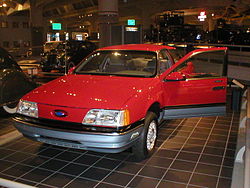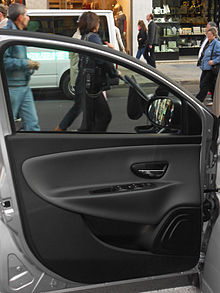- Vehicle door
-
 A 1986 Ford Taurus with its driver side door open.
A 1986 Ford Taurus with its driver side door open. Interior panel of a modern vehicle door (Lancia Ypsilon of 2011).
Interior panel of a modern vehicle door (Lancia Ypsilon of 2011).
A vehicle door is a partition, typically hinged, but sometimes attached by other mechanisms such as tracks, in front of an opening which is used for entering and exiting a vehicle. A vehicle door can be opened to provide access to the opening, or closed to secure it. These doors are similar to doors used in buildings.
These doors can be opened manually, or powered electronically. Powered doors are usually found on minivans, high-end cars, or modified cars.
Contents
Types
There are many different types of vehicle door. The following are the types:
Conventional door
An conventional door, also known as a regular door is a type of door that is hinged at the front-facing edge of the door, and so allows the door to swing outward from the body of the car. These doors are relatively safe, in that if they are opened during forward motion of the vehicle, the wind resistance will work against the opening door, and will effectively force its closure
Suicide doors
Main article: Suicide doorSuicide doors are a type of door that is hinged on its trailing edge. The term 'suicide door' was coined due to the potential for the door to fly open should the latch be released during forward motion of the vehicle.
Scissor doors
Main article: Scissor doorsScissor doors are doors that rotate vertically upward, and are hinged at or near the end of the windshield.
Butterfly doors
Main article: Butterfly doorsButterfly doors are a type of door that are similar to scissor doors, but while scissor doors move up, butterfly doors also move outwards, which makes for easier entry/exit, and saves space.
Gull-wing doors
Main article: Gull-wing doorGull-wing doors are a type of door that are hinged on their uppermost edge, at the roof rather than the side. They are so named because, when opened, the doors evoke the image of a seagull opening its wings.
Sliding doors
Main article: Sliding door (vehicle)Sliding doors are a type of door that open by sliding horizontally or vertically, whereby the door is either mounted on, or suspended from a track. They are often used on the side of commercial vans, as this allows a large opening for equipment to be loaded and unloaded without obstructing access.
Canopy doors
Main article: Canopy doorA canopy door is a type of door that sits on top of a car and lifts up in some way, to provide access for passengers. It is similar to an aircraft canopy. There are no set standards to canopies, so they can be hinged at the front, side or back - although hinging at the front is most common. Canopy doors are rarely used on production cars, but are frequently used on the 'closed' variants of Le Mans Prototype endurance race cars. They are also sometimes used on concept cars.
Door locks and latches
Most vehicle doors are secured closed to the vehicle body with latches which may be locked to prevent unauthorized access from the exterior. There are a variety of car door locking systems. Door locks may be manually, or automatically operated, and may be centrally or individually operated. Also, they may be operated by remote control, with the transmitter often integrated into the main vehicle access / ignition key.
Additionally, rear passenger doors are frequently fitted with child safety locks to prevent children from exiting the vehicle unless the door is opened from the exterior. These are also frequently used on Police cars, to prevent suspect criminals from escaping whilst in Police custody.
Vehicle door latches on practically all vehicles today are usually operated by use of a handle which requires the user to pull, lift, or tug - with some force towards themselves rather than push. There is a reason for this. As late as the 1970s, some vehicles used exposed push buttons to operate the door latch, such as certain Opel models. The unfortunate side effect of this design was that external objects which touched a vehicle during a spinout could trigger the latch; the door would pop open and eject the vehicle occupants. A death which occurred exactly that way led to the landmark legal case of Daly v. General Motors Corp., 20 Cal. 3d 725 (1978), in which the Supreme Court of California merged strict product liability with comparative fault, and thereby affirmed the right of General Motors to introduce evidence that decedent Kirk Daly flew out of his Opel not only because the door popped open, but because he was intoxicated and not wearing a seat belt.
Windows
Most vehicle doors have windows, and most of these may be opened to various extents. Most car door windows retract downwards into the body of the doors, and are opened either with a manual crank, or switchable electrical motor (electric car windows other than the driver's window can usually be controlled at both the door itself and centrally by an additional control at the driver's position). In the past, certain retracting windows were operated by direct (up or down) pressure, and were held in the up position by friction instead of by an internal lift mechanism.
Other cars, particularly older US-manufactured vans, have hinged windows with a folded lever mechanism to push and hold the window out from its closed position.
One other no-longer common configuration is a triangular quarter glass window in to fill out the forward, non-rectangular portion of the upper half of the front door. These windows pivot on a vertical access, and the portion that is pushed outside, given the angle of incidence with the car's direction of forward motion, pushes external air into the vehicle. Such windows, as found on the Nissan Sunny, are operated with and locked shut with a pivoting latch, often with a push button lock. Several older US cars feature electrically controlled varieties.
Door brakes or stays
Vehicle doors often include brakes, or 'stays', that slow the door down just before it closes, and also prevent the door opening further than its design specification. The current trend is to have a three-stage door brake.
Door brakes exist because the doors on the first vehicles were heavy, so they had to be pushed hard to make them close. Soon after, automotive manufacturers managed to construct lighter doors, but users were used to closing doors with force so doors quickly became damaged. Door brakes were then introduced to slow down the door just before the door closed to prevent damage; these soon became standard.
Usage
- Front doors
- Rear doors
- Hatch (categorised as a door in Europe, see “Door categorization” below.)
Door categorization
Hatchback and estate or station wagon bodies are sold as 'three-door' or 'five-door' models. In these cases, the rear hatch is classified as a door; this is because it enters the passenger compartment. With other vehicles such as saloons or sedans and coupés, the boot lid is not counted as a door by definition because it is for a separate storage compartment - these cars are sold as 'two-door' or 'four-door'. This system is mainly used in Europe, but is less common in North America. In Europe, the American-style labelling is occasionally used.[citation needed]
Usually in North America, cars are only sold as "two-door" or "four-door" models. This American-style labelling only includes the passengers' and driver's doors, and not hatches on hatchbacks and station wagons. This has led to many not understanding that hatches are counted as doors in Europe, whilst the lids to sealed trunks aren't.
Parts
- Door card
- Door handle
- Door switch
- Glass window
- Pillar
- Door locks which can work on a remote system
- Interior storage compartment
Door switch
Door switches are simple on/off mechanisms connected to the interior light (dome light), and may also be connected to a warning light, speaker or other device, to inform the driver when the door is not closed. The door light is standard equipment on all cars. In American cars from the 1950s-1990s, they had buzzers or "door dingers" that sounded, along with the check light, whenever any door is open.
Being doored
Some cyclists refer to colliding with an open car door as "being doored".[1] This usually happens when the cyclist is riding alongside a row of parallel-parked cars, and a driver suddenly opens his or her door immediately in front of the cyclist without first looking to see if it is safe to do so.
See also
- List of cars with unusual door designs
- Automobile
- Butterfly doors
- Canopy door
- Gull-wing door
- Scissor doors
- Suicide door
- Sliding doors
References
- ^ "get doored (verb)". Word Spy. http://www.wordspy.com/words/getdoored.asp. Retrieved 2007-10-30.
Categories:- Automotive body parts
- Car doors
Wikimedia Foundation. 2010.

